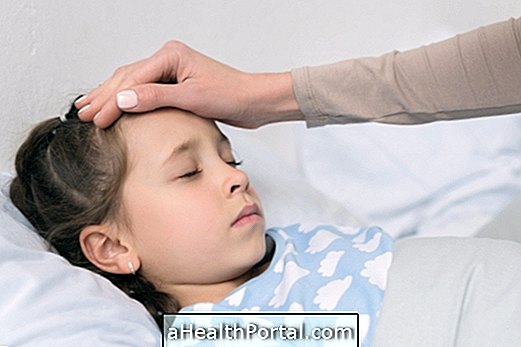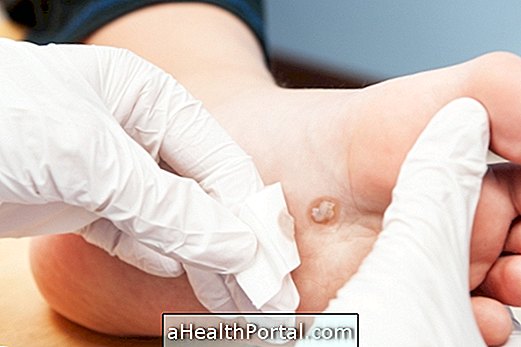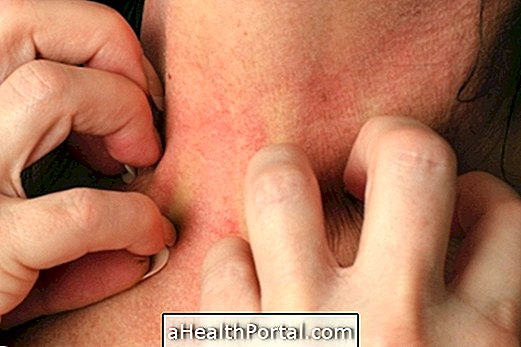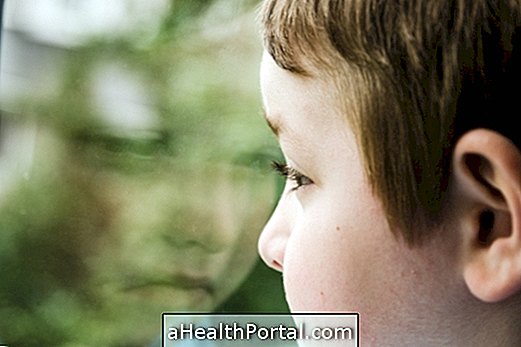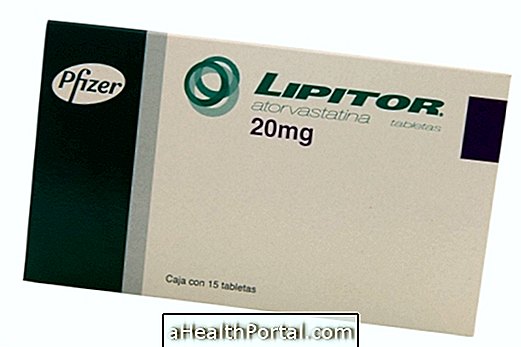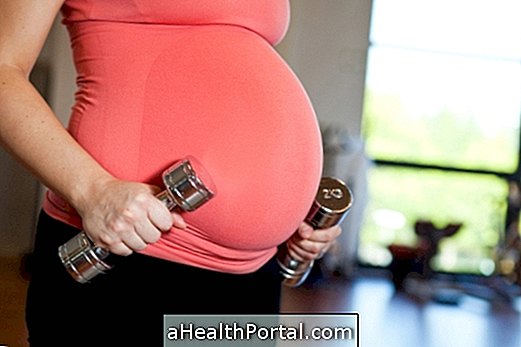Falling is the leading cause of an accident in the elderly, with about 30% of people over 65 years old falling at least once a year, with the odds increasing further after age 70 and as age increases.
The occurrence of a fall can be only an accident, however, it can also indicate problems related to the health of the elderly, and may have very negative consequences, such as reduced functions, need for hospitalization or institutionalization, rest or asylums.
In addition, if the elderly have had previous falls, the risk of presenting new falls is greater, so it is very important that prevention is already started before this type of accident happens, adopting a healthy habit of life with practice of physical activities to maintain the muscular mass and calcium of the bones, balanced diet, besides control of the chronic diseases with medical follow-up.
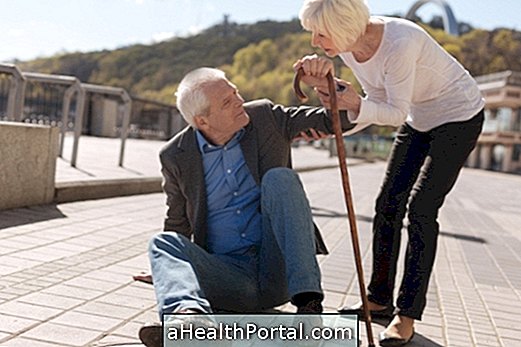
The major risk factors for falls in the elderly include:
1. Sedentary lifestyle
Lack of physical activity leads to loss of muscle strength, balance and joint flexibility, which worsens physical performance measured by gait speed or agility of sitting and standing, and leaves the elderly with more risk of falls .
The sedentary lifestyle is very frequent in the third age, since the practice of exercises is not stimulated among the elderly, which is a mistake, because the less the body moves, the greater the decline of the physical conditions and capacities. The good news is that in many cases this loss can be recovered, totally or partially, although it is not easy. Learn how to avoid losing muscle mass in the elderly and how to recover.
2. Dementia or mental confusion
Cognitive decline is usually caused by diseases such as Alzheimer's or Parkinson's dementias, for example. This situation leads to the risk of falls due to compromising posture, body perception, limb reaction during movement, and lead to less muscle strength, reducing balance.
In addition, in cases of advanced dementia, it is common for the elderly to experience episodes of agitation and lowered mental states.
3. Use of excess medications
The use of many remedies, especially when 5 or more, is a situation known as polypharmacy, and if not well followed may cause side effects or associations of drug effects. Thus, the consequences may be the existence of symptoms such as dizziness, drowsiness and drop in pressure, which can cause falls.
Some of the medications most related to these effects are antihypertensive, diuretics, sedatives or sleeping pills, some antidepressants, antipsychotics and opioids, for example.
4. Home environment
A poorly adapted environment for the elderly, with slippery surfaces, poor lighting, lack of handrails for support and with many rugs or steps is a major risk factor for falls. Observing this situation is very important because it is much more common that the fall occurs at home than in the external environment.
The use of inappropriate footwear such as slippers, such as Hawaiian, or shoes with slippery soles is also cause for falls and should be avoided.

5. Impaired balance
The balance can be worsened by several situations, especially by orthopedic or dizziness, such as labyrinthitis, postural hypotension, cardiovascular, neurological or psychiatric diseases, endocrine changes, as well as the use of medicines.
In addition, changes in the perception of the environment caused by visual difficulties, such as presbyopia, cataracts or glaucoma, or by hearing impairment are important causes of loss of balance. This perception may also be impaired by loss of skin sensitivity caused by diabetes, for example.
6. Diseases
The presence of chronic diseases, such as arthritis, osteoarthrosis, osteoporosis, cardiovascular diseases, pulmonary diseases, depression or insomnia, and acute diseases such as infections, cardiac arrhythmia, stroke or even after surgery, for example, are associated to a greater ease of falls in the elderly, as much by the impairment of the locomotion capacity as to cause greater fragility and dependence.
The greater the number of diseases, or the more severe the greater the limitation to exercise daily activities, therefore, it is important that each disease is detected and treated properly, from a regular medical follow-up.
7. Incontinence
Incontinence, both urinary and fecal, causes the elderly to feel the need to go quickly to the bathroom, which causes them to fall. It is common for the incontinent elderly person to experience episodes of falls at night, since he can try to move while it is still dark or to present dizziness when getting up.
8. Malnutrition
Inadequate nutrition leads to increased risk of disease, as well as favoring loss of muscle mass, fragility and impairment of physical performance. Older people who have diseases that make it difficult to swallow food, especially if they use probes, or who have difficulty getting around and preparing their food, are at greater risk, and caregivers should pay special attention to providing food in adequate quantity and quality.

Consequences of falls for health
Falls can have serious physical and psychological consequences for the elderly, and bone fractures, especially of the ankle, knee, femur, hip and forearm, in addition to joint injuries and head trauma, can be very limiting and are responsible for the need of being bedridden for a long time and causing a great dependence and reduction of the quality of life.
As a result, the elderly may become more limited, worsening activity levels and functionality, need for hospital stays more frequently, and in some cases this may lead to the need for daily care by a caregiver or institutionalization.
The psychological consequences include shame, loss of self-confidence, anxiety, and depression. Another serious consequence is the post-fall syndrome, a situation in which the elderly have a fear of falling again and loss of safety to move, and this makes them want to move less and avoid walking, causing serious effects related to the sedentary lifestyle, which include fragility, muscle atrophy, and increased dependence on daily activities.
How to do fall prevention
About 70% of falls occur indoors, in their different environments, such as bathrooms, kitchen, living room, stairs and garden, so it is very important that all the space where the elderly person walks is well adapted for their locomotion and for avoid accidents. Thus, it is very important to follow some guidelines, such as:
- Performing physical activities such as tai-chi, swimming, walking or body-building, for example, as a way to maintain or regain muscle strength, balance, flexibility of joints and stimulate bone health. Check out some great exercises that are suitable for seniors;
- Physiotherapy, especially when there is already a movement limitation, important for training gait, posture, balance and flexibility, as well as instructions on lifting and transferring rooms;
- Have a good medical follow-up, preferably with a geriatrician, to perform an adequate screening and treatment of diseases that may alter the elderly's ability to travel, make guidelines to the family, and limit the use of medications to only the indispensable, if excessive use of medicines, a situation called polypharmacy;
- Treating possible vision and hearing changes, with the ophthalmologist and otorhinolaryngologist, to improve the senses and balance;
- Keep the house environment well lit and adapted, with non-slip floors, adapt handrails to allow easier mobility, especially in bathrooms, hallways or near the bed, avoid rugs, objects along the way and steps along the house. It is also recommended to avoid very low or high beds and chairs. Learn more about adapting the home to the elderly;
- Wear well-fitting, comfortable footwear for the elderly, preferring an orthopedic shoe, sneakers or sandals with adjustable velcro straps, avoiding open slippers like Hawaiian or heeled shoes. It is also important that it is non-slip, with rubber soles;
- Using a support, such as a walking stick or walking stick, may be necessary to avoid falls in the elderly who have some walking limitations, which can generate more confidence and safety;
- Have a balanced diet rich in protein, milk and dairy products, vegetables, whole grains and 6 to 8 glasses of water a day to ensure good nutrition and hydration.
If the elderly person needs to go to the bathroom in the middle of the night, it is recommended that this should be as close as possible, easily accessible and that the environment can be easily illuminated. Otherwise, it is preferable to consider the need for diapers or a potty at night, avoiding a drop in the attempt to move to the toilet. Check out other tips on how to prevent falls in the elderly.


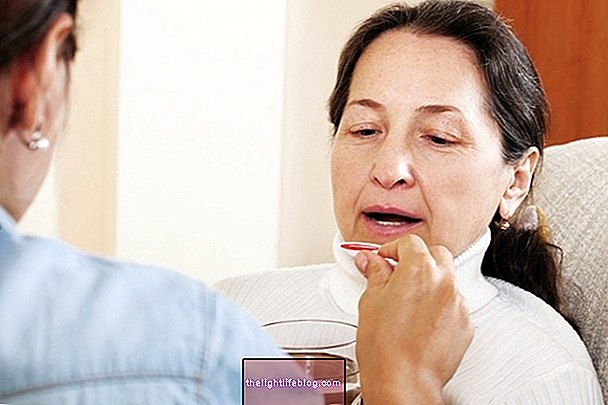
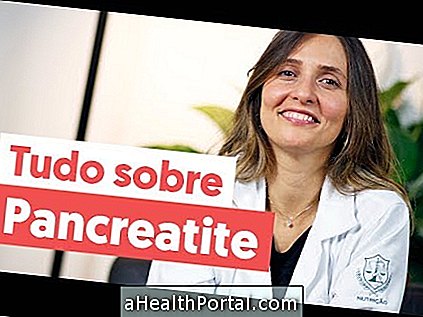
.php)

